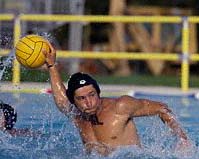A Brief History of Waterpolo
This page is for those of you who still wonder, "how do they stop
the horses from drowning?" Well, here's a newsflash: horses have
absolutely nothing to do with waterpolo. The term "polo" is the
English pronunciation of the Indian word "pulu," meaning ball. Just
as the ball game played on horseback became known as "polo," the
ball game played in water became known as "water polo," although
there in no connection between the two sports.
The game that evolved into modern water polo began as a form of
rugby football played in rivers and lakes with the object to "carry"
the ball to the opponent's side. By 1869, an Indian rubber ball
began replacing the original ball which was made from a pig's
stomach. One year later, the London Swimming Club developed rules
for football to be played in swimming pools. The first official game
was played in the Crystal Palace Plunge in London.

By 1880 in Scotland, the introduction of the Trudgeon stroke
permitted rule changes to make the game faster. The game moved from
a rugby-style to a soccer-style of play. The goal then became a cage
of ten feet by three feet and a goal could be scored by throwing the
ball into this area. The small ball was changed to a leather
association football (soccer ball). Players could only be tackled if
they held the ball and players could only touch the ball with one
hand at a time. In the late 1880s, these Scottish rules were
generally adopted throughout Great Britain.
In 1888, the United States became the next country to play water
polo when John Robinson, an English swimming instructor, organized a
team at the Boston Athletic Association. Water polo spread to
Hungary in 1889, Belgium in 1890, Austria and Germany in 1894 and
France in 1895. The game was included in the Olympic Games of 1900
as an exhibition at the Paris Games. Only club teams participated
and Great Britain defeated Belgium, 7-2, in the final game. A club
from France took third place.
In 1911, a decisive advance was made in the game when the Federacion
International de Natacion Amateur (FINA) made the English-Scottish
rules obligatory for all member nations. It is fair to state that not
until the 1920 VII Olympiad in Antwerp,
when twelve nations competed, did the game really become popular and
internationally represented. Even then, the Germans, Austrians and
Hungarians were not permitted to participate due to their
involvement in World War I.
Beginning in 1928, first Germany and then Hungary began a reign of
dominance over international water polo that lasted into the 1980s,
when Yugoslavia, the United States, the USSR, Italy and Spain all
fielded extremely competitive teams.
|